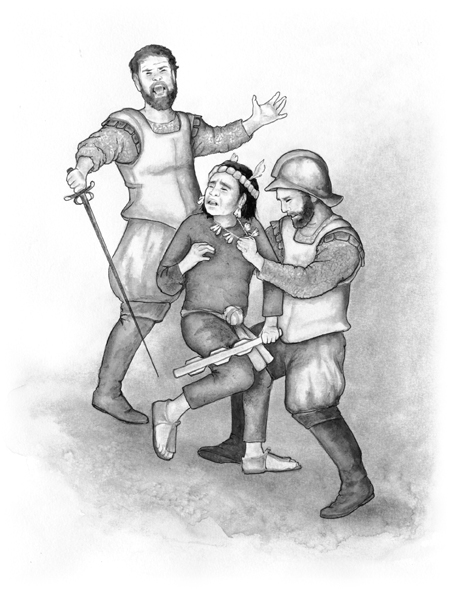
The more they learned of the God the Spaniards worshipped, the more the native converts loved him. The more they received the sacraments, the more their hearts became enflamed. Even though there were soon a number of devoted Indians, Bishop Juan Zumarraga had expected many more of the people to convert to Christianity. Unfortunately, two forces opposed the work of the Catholic missionaries. The first was the resistance of the Aztecs to this “new” religion. “They see it as destroying their power over other tribes,” the bishop noted. And because he was a learned and compassionate man, Bishop Zumarraga understood the Aztecs’ deeper motives. “They have become so dependent on their superstitious belief in gods that they truly believe there will be a catastrophe if these gods are not served.”
Since many Aztecs and members of other tribes had become good friends with the Spaniards and were willing to fight against Montezuma, the emperor’s warriors became even fiercer. “We refuse to hear about this God!” many protested. “We must continue to worship our gods who feel slighted now that some are adoring this ‘God through whom everything lives!’”
The second force the bishop and the missionary priests faced was the evil of many of their own countrymen, the conquistadors or Spanish conquerors. While it was true that Cortes and his men wanted to see the spread of the Christian religion, they had other aims, too. “Spain’s authority must be spread further into the world!” Cortes asserted. Under the command of the Spanish conqueror Diego Velasquez, Cortes had assisted in taking Cuba, where he had settled, marrying and building up a fortune through plantations and mines. He saw many further opportunities in Mexico. Even when Velasquez changed his mind about sending Cortes to explore Mexico, Cortes helped himself to ships and supplies and set sail with his men while Velasquez slept.
New explorers arrived in Mexico soon after Cortes first landed there. The greed of many of them equaled the zeal of the good friars. These conquistadors took advantage of the innocent and trusting nature of the Indians, either tricking or killing them for their gold. The Indians said, “Gold is good for ornamentation, but it has no money value. The shining dust that comes out of the earth crazes these foreigners! Gold is not even as valuable as dirt.... At least dirt has the power to grow things!”
Some conquistadors killed the Indians for their gold.
The Spanish king had sent a delegation of men to oversee and govern his new colony. The cruel and unfair practices of these Spaniards saddened and outraged Bishop Zumarraga. He and his priests were becoming more and more frustrated in their attempts to spread the Good News of Jesus to the native peoples. “How can we, who practice the Catholic faith, convince the Indians about its truth and beauty if corrupt men profess to be followers of this same faith?” the bishop cried. And he was right.
Because of the foreigners who were evil, the Indians began to suspect all foreigners. It was becoming very hard for Bishop Zumarraga to win new friends for God and for God’s universal Church. The situation even meant danger for his friars. The bishop needed a miracle as badly as the Indians needed one!
Bishop Zumarraga prayed for a sign. “Make it miraculous, not coincidental, Lord,” he begged, “so that I may be sure of your holy will! The Castilian roses of my homeland do not grow here,” he continued. “If you wish me to keep the missionaries here during this dangerous time, let someone give me Spanish roses.” Roses were also a symbol of Mary, the Immaculate Conception, who was the patroness of his friars. “The choice of a rose shows that I desire that this sign come through your Mother’s holy hands,” Bishop Zumarraga prayed.
Because of the bishop’s fervent prayer, and because the Aztecs used the symbol of flowers to signify blood, killing and sacrifice, the sign that Mary would use was to have great meaning. She would use flowers not only to remove the bishop’s fears, but also to reverse the Aztecs’ thinking. She wanted to make it clear that her flowers did not signify the blood of death, but instead, the blood of her Son, Jesus, who is new Life for all people.